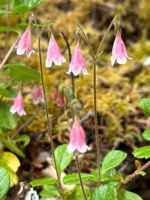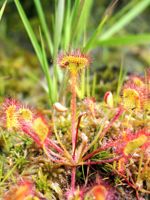Mon-Fri 9am - 5pm Mountain time
Round-Leaved Sundew vs Twinflower
Linnaea borealis
Drosera rotundifolia
CUSTOM GROW
CUSTOM GROW
Twinflower is a native, trailing evergreen ground cover known for its delicate flowers that grow in nodding pairs. These pale pink blooms are described as being sweetly fragrant, attracting native bees and other pollinators.
Growing in cool, moist, acidic soils, the trailing stems form roots as they spread and start to form mats across the forest floor. Due to its woody stem, it is technically classified as a shrub and often referred to as a subshrub or dwarf shrub. This species is well-suited for naturalization, restoration, and conservation projects.
Twinflower (Linneae borealis) was named in honour of Carl Linnaeus, who adopted it as his personal emblem.
Round-Leaved Sundew is a native carnivorous plant, easily recognized by its bright green leaves covered in distinctive red, glandular hairs. These hairs secrete a sticky substance that is used to attract, trap, and digest insects. Their carnivorous nature allows them to survive in nutrient-poor, acidic soils where many other plants may struggle to grow.
They produce small white flowers that grow along the top of a slender, leafless stem. They can be found growing in wetlands, most often among sphagnum moss, in consistently moist, acidic soils. It does best in cooler summer climates and is intolerant of shade. Due to its small size, the plant can be difficult to spot in its natural habitat. Round-Leaved Sundew is an indicator of healthy wetland systems and is valued in ecological restoration and conservation projects.

